-
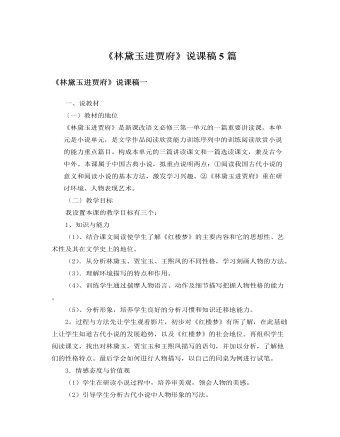
人教版高中语文必修3《林黛玉进贾府》说课稿5篇
【教学目标】我设置的本课的教学目标有三个:1、知识与技能(1)了解曹雪芹及《红楼梦》(2)学习通过一个人物的行踪、所见所闻,介绍典型环境,认识封建贵族阶级豪奢极耻的生活以及森严的等级、礼仪制度(3)分析小说人物出场的描写艺术,培养学生分析小说人物形象的能力。(4)一叶落而知秋”,通过对“林黛玉进贾府”这一故事情节的把握是否能引发对《红楼梦》的认知兴趣,并找到一个突破口,有针对性地进行自主探究,进而进行个性化解读。(5)整体认知小说,认识小说悲剧的必然性和思想价值.2、过程与方法(1)用直观演示和归纳探究法分析文章要点。(2)用讨论探究法体验作者对文中人物的情感态度。3、情感态度价值观(1)正确理解《红楼梦》的思想内涵,培养学生热爱祖国传统文化的思想感情。(2)认识封建大家族的腐朽没落,理解贾宝玉追求个性自由反封建的精神。
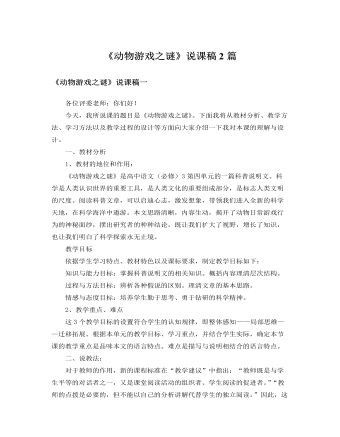
人教版高中语文必修3《动物游戏之谜》说课稿2篇
一、导入新课人类社会越来越现代化,新科学技术日新月异,令人目不暇接,称之到了“知识爆炸”的时代也毫不为过。由此而来的是生活的快节奏,学习和工作的竞争也越来越激烈。这种竞争一直波及到了儿童,加之中国几千年来形成的望子成龙的传统观念,使作父母的把一切希望都寄托在孩子身上,实现自己未能实现的理想。祖孙三代4、2、1的局面,使12只眼睛都盯在了孩子身上,真是走路怕摔着,吃饭怕噎着,干活怕累着,要星星不敢摘月亮,要吃什么跑遍全城也要买来。这种过分保护、溺爱及过早地灌输知识会得到什么结果呢?乐观者说孩子越来越聪明,越来越早熟,将来能更好适应现代化的要求;悲观者则认为豆芽菜式的孩子将来经不起风浪,小皇帝太多了很难凝聚成统一力量,将来谁去当兵,谁去干那些艰苦创业性工作……。对孩子本身来说,是幸福还是……在此不想多发议论,还是让我们来看看动物世界的孩子们吧,也许会得到某种启迪。
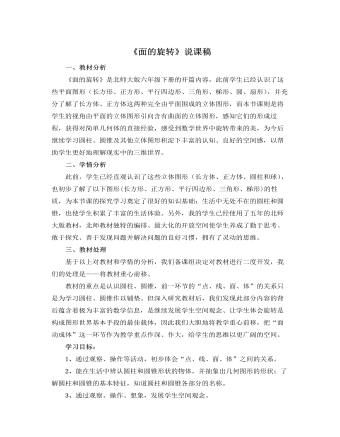
北师大版小学数学六年级下册《面的旋转》说课稿
2.放大空间,升华思考由于我对教材的二度开发留给了学生足够的探索空间,课上学生探索数学的热情被充分调动,我们欣喜地看到:有的学生尝试着不同平面图形的旋转;有的学生只用一种平面图形,却旋转出不同的立体图形;有的学生的思维并没有停留在表象上,而是在深入地思考产生这一现象的原因……交流时学生的发现远远超出了我们的想象,这份生成带给我们的是惊喜,是赞叹,更是“以操作促思考”的教学行为结出的硕果。3.巧用课件,形成表象本节课,我充分运用现代信息技术将平面图形经过旋转形成立体图形的过程生动、逼真地再现出来,帮助学生将抽象的空间想象化为直观,进而形成表象,深植于学生的脑海中,促进了学生空间观念的形成。总之,在这节课上,我坚持把“促进学生发展”作为第一要素贯穿于课堂教学的始终,让学生在充满着民主、探究、思考的氛围中,积极操作、主动思考,发展了学生的空间观念。
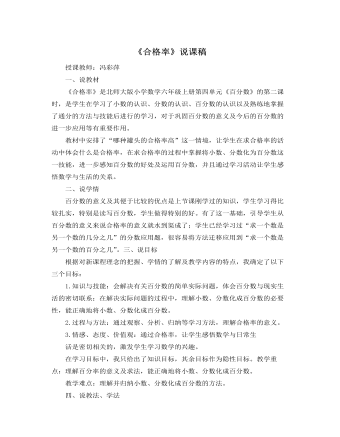
北师大版小学数学六年级上册《合格率》说课稿
四、说教法、学法我在教学中主要采用的教学方法是先学后教中的“两学两教”。辅之以多媒体教学手段(主要通过微课视频的观看学习)。本课学生的学习方法主要有:自主发现法、合作交流法、自学尝试法等。1.学生在自主探究解答例题,求两种品牌罐头的合格率时,主要采用自学尝试法,根据知识的迁移,学生能够正确求出产品合格率。2.在总结小数、分数化成百分数的方法时,学生主要采用自主发现,合作交流的方法。首先让学生观察例题板书,想一想怎样把小数、分数化成百分数,采用了“兵教兵”的方法,达到了人人参与的目的。当然,由于学生所处的文化环境,家庭背景和自身思维方式的不同,不同的学生所采用的方法也不尽相同,作为教师要尊重学生的选择,允许学生用自己喜欢的方式学习数学。五、说教学过程
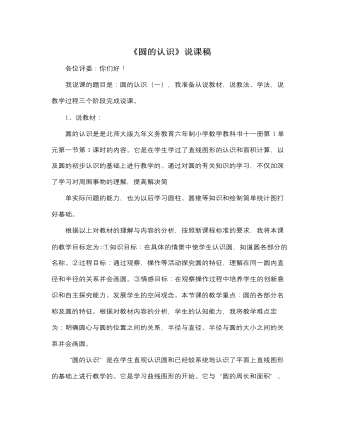
北师大版小学数学六年级上册《圆的认识》说课稿
④联系生活实际解决身边的问题,让同学初步感受数学与日常生活的密切联系,体验数学的应用,促进学生的发展。接下来,我再具体谈一谈这堂课的教学过程。3、说教学过程第一环节:创设情境,激qing导入。同学们你们看屏幕上的是什么?(出示图片)那么自行车车轮是什么形状的?为什么车轮要设计成圆形?这里面有什么奥妙呢?学了今天的内容大家就会明白的。这节课我们就走进圆的世界去探寻其中的奥妙。板书课题:圆的认识设计意图:通过生活中实际例子引入课题,一方面引起学生的学习兴趣,另一方面为学习新知识做了铺垫,从思想上吸引了学生主动参与学习的活动。这一环节的设计,主要是想体现数学就在我们的身边,从而激发学生学习的兴趣及学习的积极性。

人教版高中英语必修4Body Language说课稿4篇
Textbook: Senior English for China (Book 4), by Liu Daoyi Time Allotment: 1 period (40 minutes)Date: March 20, 2014Teaching aids: blackboard, Multi-media, Power Point, chalk I. Text Analysis (教材分析)This unit is about body language, and the text selected in the reading part demonstrates the difference and similarity of body language in many parts of the world. Through learning this passage, students are required to raise their awareness of using body language in different parts of the world. As body language is closely related to our daily life, it is easy to arouse students’ interest in learning this text. Reading skills and speaking training are designed around the text.II. Teaching Objectives (教学目标)By the end of the lesson, students will be able to:1. Language Skill Objective(语言技能目标): develop reading ability (skimming and scanning)as well as speaking ability.2. Cultural Knowledge Objective(文化知识目标): know about the cultural differences of using body language.3. Affective Objective(情感目标): increase students’ awareness of using body language correctly in different cultures. III.Teaching Focuses and Difficulties(教学重点和难点)1. Teaching Focuses(教学重点): the difference and similarity of body language in many parts of the world.2. Teaching Difficulties(教学难点): develop students’ reading abilities of skimming and scanning and ask the students to show their opinions with fluent English.

人教版高中英语必修2Computers说课稿3篇
一. 教材分析1. 本单元的中心话题是“计算机(Computers)”,内容涉及计算机的发展历史,计算机的应用等。本节课是该单元的第一课时,我将Warming up, Pre-reading and Comprehending这四部分整合为一节精读课。其中。Reading部分是题为WHO AM I?的文章,以第一人称的拟人手法介绍了计算机发长演变的历史和计算机在各个领域的应用,其主旨是表达计算机的发展变化之快以及在生活中用途之广。而Warming up部分以图片的形式展现了计算机的发展历程;Pre-reading中的问题和排序分别是为了预测语篇的内容和测试学生对计算机历史了解的情况;Comprehending则通过各项练习训练学生的阅读技能,从而加深对文章的理解。可见这几部分是一个有机的整体。2. 教学目标:1) 语言目标:重点词汇及短语:abacus, calculate, calculator, PC, laptop, PDA, robot, analytical, technological, universal, mathematical, artificial, intelligent, network, explore, in common, as a result.重点句子:a. My real father was Alan Turing, who in 1963 wrote a book to describe how computers could be made to work, and build a “universal machine” to solve any mathematical problem.

人教版高中英语必修3Astronomy the science of the stars说课稿3篇
Step 2 Pre-listeningAfter students finish their discussion, I will show a picture of Newton and ask them: Who is him? What is he famous for? Could you find out some words to describe him? Maybe students will answer that he is genius for his finding of theGravitation, making a great contribution to the progress of human being. At that time I will show another two pictures of Einstein and Hawking, letting students guess who they are and write down their idea about the Gravitation. For I have arranged them to search more information about the gravity before this class, Students have beenfamiliar with the topic and will not be afraid about this abstract conception, which is helpful for their listening.Step 3 While-listeningIn this step, students will be required to listen the material for three times. The first and listening is extensive listening and the second and third listening is intensive listening. In the first time, They are required to listen a material including Part 1 and Part 2 and choose the best summary of the listening text. After they choose the right answer, They also need work in group to explain what is wrong with the others. Then I will make a conclusion that we should pay attention to the first paragraph and last paragraph and some keys to get the main idea. By doing this, their capacity of generalization will have a great improvement.Before the second listening, I will ask students to scan the blank on the power point quickly and ask them to note down some key words .Then ask them to listen to the Part 1again and fill the first column of the chart. Maybe some students just show the ideas of these three scientists an still can’t catch their development of gravity. Therefore, I will ask them to listen to Part 2 again and fill in the rest. After finish the listening, I will give them ten minutes to discuss with their partner. I will also guidethem to improve their answers when they discuss with others.

人教版高中英语必修4Women of achievement说课稿4篇
Good morning, distinguished judges:It’s my honor to talk about my teaching ideas with you. Today my topic is Women of Achievement. My presentation consists of six parts: the analysis of teaching material and student, teaching aims, key and difficult points, teaching and studying method, teaching procedures and blackboard design.First, let’s focus on the analysis of teaching material. This lesson is from New Senior English for China Student’s Book 4 Unit 1, the reading part. The main topic of the passage is the introduction of a student of Africanwildlife. After this lesson, the students will learn more information about her studying chimps in Africa, and their reading and speaking abilities can be developed as well.The next part is the analysis of students. My students are in senior high students. They have learnt English for many years, they’ve known many words and sentences, but their speaking and reading abilities are still not very good. So I will practice their speaking and reading abilities through different exercises.According to the New Standard Curriculum and the present situation, I set the teaching aims as follows: firstly, knowledge aims. Students can grasp some new words, such as worthwhile, move off. Moreover, students can understand the content of the passage and get familiar with the topic of studying chimps in wildlife. Secondly, ability aims. Students can use reading strategies such as skimming and scanning in reading process. Thirdly, emotional aims. Students can have the awareness of protecting animals and care about animals.Based on the above analysis, the key point of this lesson is to get the main idea and the detailed information from the passage; the difficult point is to talk about the wildlife protection and use reading strategies.

人教版高中英语必修4Working The Land说课稿3篇
Knowledge objectives:(1) to make Ss grasp the usage of words, expressions and sentence structures: statistics, struggle, thanks to, rid of, some patterns for persuasion, the “ing” form as subject and object;(2)to use learnt knowledge to persuade sb.Ability objectives:(1) to develop Ss’ reading skills(skimming, scanning, word guessing);(2) to improve Ss’ speaking, communicating and cooperating skills.Emotional objectives:to make Ss know the contribution of Yuan,and learn his spirit and his simple life time.Teaching important and difficult points:(1) some words, expressions and sentence structures mentioned above;(2)the content of the text;(3)training their reading and speaking skills.Teaching methods: CLT, TBLT,QT.Learning strategies: CLS, QLS, TBLS.Teaching procedures:Step 1 lead-in: (1) teacher plays a piece of recent news from CCTV about the harvest of the super hybrid rice, and ask students whether they know Yuan or not, and talk about him and his contribution.(2)Brain storm: let Ss describe Yuan in their minds including his appearance, his living condition and so on.Step 2 fast reading tasks:(1)teacher introduces Yuan and super hybrid rice(2)make Ss read the text as fast as possible with questions. Such as: what’s the general ideaof this passage? What’s Yuan’ dream? (skimming and scanning skill)Step 3 intensive reading tasks(1)let Ss read the text silently, find topic sentence of each paragraph and draw the difficult sentences and the knowledge what they don’t understand.(words guessing)(2)teacher and Ss talk about the important words, expressions and sentences together, and ask Ss to retell the content of the text.(summarizing and paraphrasing)(3)teacher summarize this part.(4) read again following the courseware.

人教版高中英语必修5Life in the Future说课稿5篇
Good afternoon, everyone. It’s my great pleasure to be here sharing my lesson with you. The content of my lesson is Senior English for China Book5 Unit 3 Life in the Future. I’ll be ready to begin this lesson from six parts: Analysis of the teaching material, Analysis of the students, Teaching aims and important and difficult points, Teaching methods and aids, Teaching procedures, and Blackboard design. First, let me talk about the teaching material.Part 1 Analysis of the Teaching Material:This unit is about what human beings’ life will be like in about one thousand years. By studying of this unit, we’ll Enable the students to know the changes in humans’ life and some new inventions bringing about the change and develop the interest in science. This lesson plays an important part in the English teaching in this unit. This is an important lesson in Book Five. From this lesson, it starts asking the Ss to grasp contents of each passage. Therefore, this lesson is in the important position of the teaching material. If the Ss can learn it well, it will be helpful to make the Ss learn the rest of this unit.Part 2 Analysis of the SsAs Senior2 Ss, they are at different levels of English fluency, some of them have lost interest in English. So during the lesson, I arrange a variety of activities to let all of them join in to attract their interest and let them be confident and taste the joy of success.
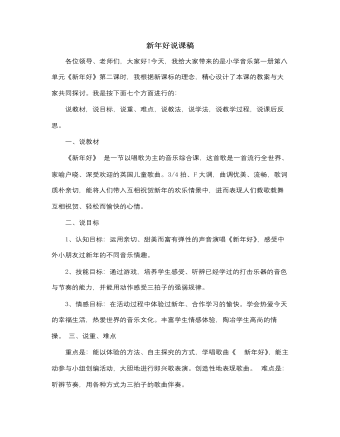
人音版小学音乐一年级上新年好说课稿
一、说教材《新年好》 是一节以唱歌为主的音乐综合课,这首歌是一首流行全世界、家喻户晓、深受欢迎的英国儿童歌曲。3/4拍、F大调,曲调优美、流畅,歌词质朴亲切,能将人们带入互相祝贺新年的欢乐情景中,进而表现人们载歌载舞互相祝贺、轻松而愉快的心情。二、说目标1、认知目标:运用亲切、甜美而富有弹性的声音演唱《新年好》,感受中外小朋友过新年的不同音乐情趣。2、技能目标:通过游戏,培养学生感受、听辨已经学过的打击乐器的音色与节奏的能力,并能用动作感受三拍子的强弱规律。3、情感目标:在活动过程中体验过新年、合作学习的愉快。学会热爱今天的幸福生活,热爱世界的音乐文化。丰富学生情感体验,陶冶学生高尚的情操。 三、说重、难点重点是:能以体验的方法、自主探究的方式,学唱歌曲《 新年好》,能主动参与小组创编活动,大胆地进行即兴歌表演。创造性地表现歌曲。 难点是:听辨节奏,用各种方式为三拍子的歌曲伴奏。
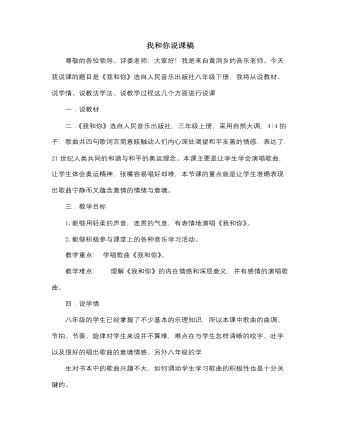
人音版小学音乐三年级上册我和你说课稿
6.欣赏第二版本。 师:关于歌曲《我和你》,还有一个鲜为人知的小故事,歌曲的原唱其实另有他人。最初作曲家陈其钢选了非常有实力的两位歌坛新秀来演唱,导演张艺谋认为一定要选择知名度很高的歌手,两人还因此大吵了一架,据说原唱的歌声更加轻盈,更加动听,你们想听一听吗?7.演唱常石磊版。 师:大家知道了,为了更好地表现出这首歌的宁静简单的气质,我们的演唱要最大限度地轻盈、柔和,就像天使的声音一样纯净。下面该轮到同学们来演唱了。注意眼睛看老师的手势,控制好气息,有表情地演唱。8.钢琴伴奏演唱。师:通过演唱,同学们肯定都感受到了这首歌曲的动人之处。下面我想请同学们站起来,想象我们来到宽敞的户外,把心放在天地间,让我们跟着钢琴伴奏,用我们纯净美妙的歌声来演绎。
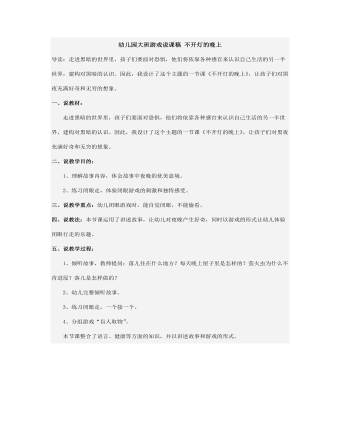
幼儿园大班游戏说课稿 不开灯的晚上
走进黑暗的世界里,孩子们要面对恐惧,他们将依靠各种感官来认识自己生活的另一半世界,建构对黑暗的认识。因此,我设计了这个主题的一节课《不开灯的晚上》,让孩子们对黑夜充满好奇和无穷的想象。 1、理解故事内容,体会故事中夜晚的优美意境。 2、练习闭眼走,体验闭眼游戏的刺激和独特感受。
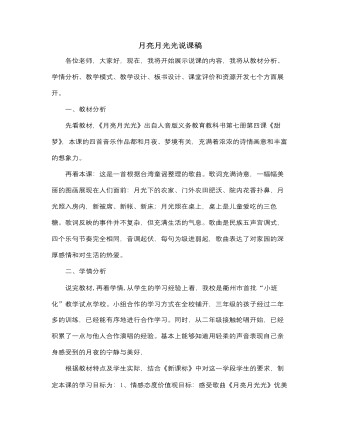
人音版小学音乐四年级上月亮月光光说课稿
结合合作学习评价的特点,本课堂中实行多元评价,一是个人评价与小组集体评价相结合。二是重视学习过程评价与学习结果评价相结合。教师主要对学生在学习过程的态度:倾听、交流、协作情况,作评价,做得好的小组“加星换积分”,表现突出的个人“奖小圆片换积分”在课末对学生表现作统计,一个月下来,表现突出的小组被评为明星小组,并给予小礼物的肯定和鼓励。七、资源开发针对《月亮月光光》一课的教学设计,我充分的利用了课本资源、网络资源和学生自身的资源。其中在课本资源的开发利用上:在小组合作的简谱视唱环节最大限度地利用了歌谱这个课本资源。在学生自身资源的利用上:充分发挥学生的合作学习能力,放手让学生自主学习旋律。在多媒体网络资源的开发利用上,我运用多媒体,帮助学生理解,刺激学生的感官,在学生的脑海里留下深刻印象等。
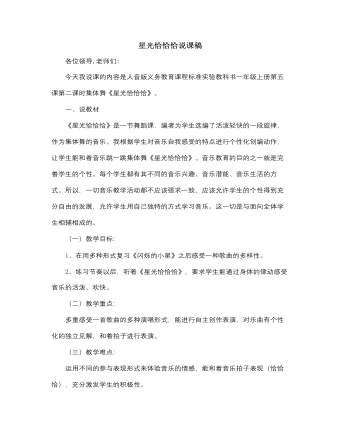
人音版小学音乐一年级下星光恰恰恰说课稿
为了进一步激发学生表演,我特意加上了舞蹈比赛这一环节, 每两小组分别表演,其他四个小组投票选择,选出优胜组,最后胜出的三个小组,再向大家展示。让学生多练多跳,激发起学生的参与意识.四、发展阶段让学生思考能变换什么队形,两人结伴或者几个人,学生自己编创组合队形。在本节课中,这个环节比较符合教学内容,通过自己的创作体验,学生就有了创新,有了突破,这就是创造性的体现,也是发展个性的体现.五、总结阶段本课我采用了归纳式的结尾,来归纳本课的教学内容,提出优点,缺点及改正方向.本课的课件为图文结合法,目的是激发情趣.,重点突出,一目了然,充分展现乐曲意境,让学生有身临其境之感.总之本课的设计考虑到了音乐学科的特点,课时的教学任务,学生的年龄特点等因素,运用各种教学媒体辅助教学,尤其是电脑媒体的介入,应该能使得课堂气氛活跃,让学生的学习兴趣,始终处于积极状态,充分体现了音乐、美术加以综合的审美育人功能.
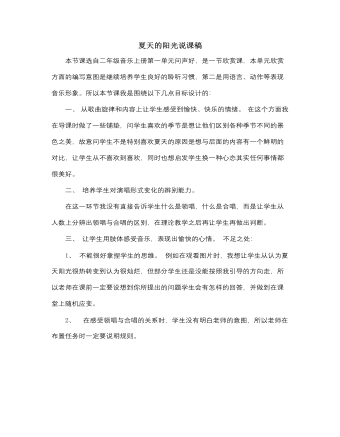
人音版小学音乐二年级上册夏天的阳光说课稿
让学生从不喜欢到喜欢,同时也想启发学生换一种心态其实任何事情都很美好。 二、 培养学生对演唱形式变化的辨别能力。 在这一环节我没有直接告诉学生什么是领唱,什么是合唱,而是让学生从人数上分辨出领唱与合唱的区别,在理论教学之后再让学生再做出判断。 三、 让学生用肢体感受音乐,表现出愉快的心情。 不足之处: 1、 不能很好拿捏学生的思维。 例如在观看图片时,我想让学生从认为夏天阳光很热转变到认为很灿烂,但部分学生还是没能按照我引导的方向走,所以老师在课前一定要设想到你所提出的问题学生会有怎样的回答,并做到在课堂上随机应变。 2、 在感受领唱与合唱的关系时,学生没有明白老师的意图,所以老师在布置任务时一定要说明规则。
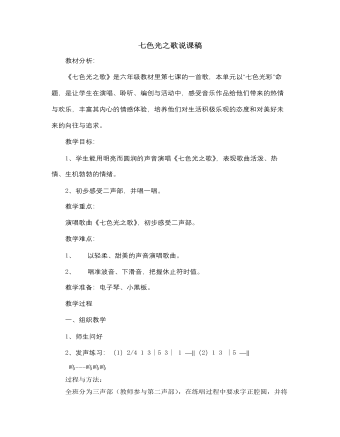
人音版小学音乐六年级上册七色光之歌说课稿
本课我的设计初衷是希望同学们能通过节奏训练,视唱训练将歌曲一步步潜移默化的吸收和掌握。但从学生的表现来看,并不受用。主要原因我反思了下,第一,没有考虑到学生的实际情况,在学生的概念里对音乐课就是玩一玩唱一唱就可以了,讲过的知识也只是听一听而已,并不会刻意的去记一记。学生们的底子也比较薄弱,所以在课堂上所提到的知识点,学生基本上已经忘得差不多了,使练习环节没有达到预期的效果。第二,在课堂上我太过注重将本课设计内容全部完成,却忽视了学生学习情况。第三,在教学中,很多地方太过于专业,使学生上课觉得与知识产生的距离感,导致学生对本课的兴趣减弱。对于以上那个问题,在今后的教学中我会特别注意,音乐基础知识会用一些简单易懂的方法在每节课一点点渗透,让他们在无形之中掌握。课堂上会多关注学生学习情况,掌握情况。切实从学生们的实际出发,让他们真正爱上音乐课,受益于音乐课。
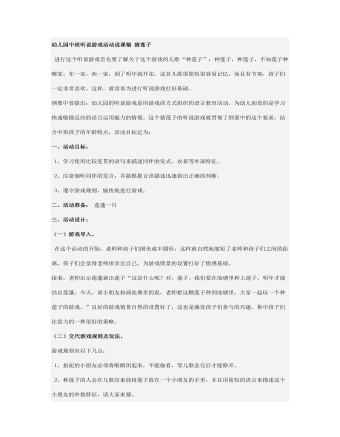
幼儿园中班听说游戏活动说课稿 猜莲子
规则讲完后,孩子们围坐成半圆形,眼睛闭上,手背在后面手掌向上,这样就可以接住老师递过来的莲子。大家开始念游戏儿歌“种莲子”:种莲子,种莲子,不知莲子种哪家。东一家,西一家,到了明年就开花。老师边说儿歌边从每个孩子身后走过,并且把莲子悄悄放入一个孩子手中。最后走到中央,描述这个孩子的特征,如“我把莲子种在一个短头发的女孩手里,她穿着黄衣服、蓝裤子和黑皮鞋”,请孩子们都来猜,猜对了,有莲子的小朋友就要到前面来说“我就是穿黄衣服、蓝裤子和黑皮鞋的短头发小女孩”,然后游戏继续。在大家一起念“种莲子”儿歌的时候,老师要注意纠正个别不正确的发音,鼓励孩子们声音宏亮的念儿歌,提醒孩子种莲子和拿到莲子以后都要注意保密,为孩子们自主游戏做好铺垫。这一步非常重要。为了保证孩子在下一步按规则玩游戏,在孩子感知理解游戏规则的基础上,老师根据孩子掌握程度可以带领着多玩几遍这个游戏。
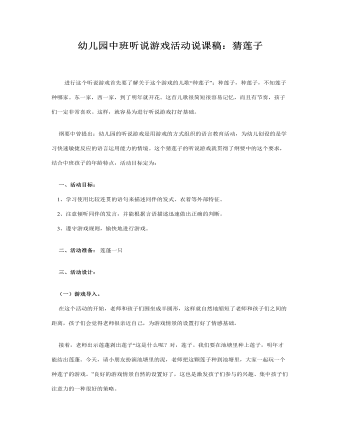
幼儿园中班听说游戏活动说课稿:猜莲子
一、活动目标: 1、学习使用比较连贯的语句来描述同伴的发式、衣着等外部特征。 2、注意倾听同伴的发言,并能根据言语描述迅速做出正确的判断。 3、遵守游戏规则,愉快地进行游戏。 二、活动准备: 莲蓬一只 三、活动设计: (一)游戏导入。 在这个活动的开始,老师和孩子们围坐成半圆形,这样就自然地缩短了老师和孩子们之间的距离,孩子们会觉得老师很亲近自己,为游戏情景的设置打好了情感基础。 接着,老师出示莲蓬剥出莲子“这是什么呢?对,莲子。我们要在池塘里种上莲子,明年才能结出莲蓬。今天,请小朋友扮演池塘里的泥,老师把这颗莲子种到池塘里,大家一起玩一个种莲子的游戏。”良好的游戏情景自然的设置好了,这也是激发孩子们参与的兴趣、集中孩子们注意力的一种很好的策略。